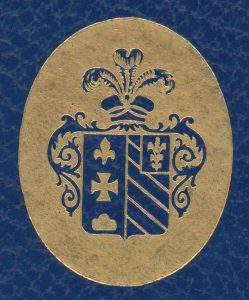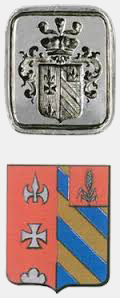History of the Coat of Arms
By patent letter dated September 19th, 1810, the Emperor Napoleon I conferred these Coat of Arms to Jean-Conrad Hottinguer: Part in 1st, "gueules à la croix pattée", accompanied in chief of a halberd iron (fer de hallebarde), and in point of a coupé of three pieces moving from the shield; to the II, bandage of gold and azure and six pieces.
In accordance with the heraldic regulations of the nobility of the empire, the composition of the arms obeys strict rules. Thus, in the upper right-hand corner of the armorial escutcheon is a "franc-quarter of gules a senestre bearing an ear of silver wheat placed in pal" characteristic sign of the title and function of Jean-Conrad Hottinguer, who was a proprietor baron.
As in many cases, the arms formerly worn by the Hottinguer family, originally from Zollikon, were taken over. However, the Swiss barré became a bandé in the French composition. Moreover, the arms attributed by Napoleon 1st are much more stripped than the original Swiss arms.
At the restoration, the Hottinguer naturally obeyed the legislation in force and carried the arms granted under the Empire, slightly modified from the composition attributed by the Empire. Thus disappears the franc-quarter of the barons owners and the imperial toque. The arms attributed and worn by Jean-Conrad Hottinguer became fossilized in the heraldic sense of the term.
When licensed as a bank in 2006, Jean-Philippe retains as the logo the original arms of the founder Jean-Conrad, except for the original colors, to highlight the continuity of his ancestor's project.

